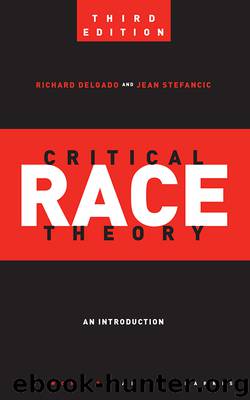Critical Race Theory by Richard Delgado & Jean Stefancic & Angela Harris

Author:Richard Delgado & Jean Stefancic & Angela Harris
Language: eng
Format: epub
Tags: Discrimination & Race Relations, Law, Jurisprudence, SOC031000 Social Science / Discrimination & Race Relations, Social Science
Publisher: NYU Press
Published: 2017-03-07T00:00:00+00:00
C. Other Developments: Latino and Asian Critical Thought, Critical Race Feminism, LGBT Theory
As the bright lines of the black-white binary blurred, critical Asian and Latino thinkers felt freer to put forward their own unique perspectives. Invigorated, perhaps, by the antiessentialist strand of critical race theory, LatCrit scholars have called attention to such issues as immigration, language rights, bilingual schooling, internal colonialism, sanctuary for Latin American refugees, and census categories for Latinos. They have begun challenging “proxy discrimination,” in which a discriminator targets a Latino on the basis of a foreign accent, name, or ancestry. They reexamine documents such as the Treaty of Guadalupe Hidalgo in search of sources of protection for land, culture, and language rights. (See Lobato v. Taylor, 71 P.3d 938 [Colo. 2002]; Mabo v. Queensland, 1991 WL 1290806 [HCA 1992].) Like Asians, many Latinos vigorously oppose the English-only movement and engage in spirited discussions of passing and assimilation (see chapter 4). They deploy the sociological notion of nativism to name and explain the recent spate of measures aimed at foreigners and immigrants, including “probable cause” laws that encourage police to stop and question the foreign-looking or to punish anyone who aids, hires, or rents an apartment to an undocumented person. They point out that nativism against Latinos and Asians thrives during times of economic hardship, when the labor supply is glutted, when workers are insecure, and when politicians rail against foreigners taking American jobs. Both groups staunchly resist the black-white paradigm but try to maintain friendly relations with African Americans. They also support immigration activists, such as the student “Dreamers” and their families who are protesting draconian immigration policies and deportation. They support histories of nonblack minority groups, such as the Ellis Island Immigration Museum’s new exhibit showing stories of Mexican border-crossers and their routes and travails.
Some Asian American writers focus on accent discrimination and the “model minority myth,” according to which Asians are the perfect minority group—quiet and industrious, with intact families and high academic aspiration and achievement. This myth is unfair to the numerous Asian subgroups such as Hmong and Pacific Islanders who are likely to be poor and in need of assistance. It also causes resentment among other disfavored groups, such as African Americans, who find themselves blamed for not being as successful as Asians supposedly are. (“If they can make it, why can’t you?”).
Allied with the model minority myth is the idea that Asians are too successful—soulless, humorless drones whose home countries are at fault for the United States’ periodic economic troubles. Such was the tragic fate of the Chinese American Vincent Chin, killed in 1982 by two Detroit autoworkers upset with Japan for destroying the U.S. automotive industry by producing better cars. To make matters worse, American courts have sometimes been reluctant to punish such racially motivated crimes against Asians, handing out light sentences. For murdering Chin, the two attackers received sentences of three years’ probation and small fines. Neither served a day in jail.
During World War II, when over one hundred
Download
This site does not store any files on its server. We only index and link to content provided by other sites. Please contact the content providers to delete copyright contents if any and email us, we'll remove relevant links or contents immediately.
| General | Discrimination & Racism |
Nudge - Improving Decisions about Health, Wealth, and Happiness by Thaler Sunstein(6657)
iGen by Jean M. Twenge(4714)
The Fire Next Time by James Baldwin(4364)
Adulting by Kelly Williams Brown(3700)
The Sports Rules Book by Human Kinetics(3611)
The Hacking of the American Mind by Robert H. Lustig(3597)
The Ethical Slut by Janet W. Hardy(3528)
Captivate by Vanessa Van Edwards(3319)
Mummy Knew by Lisa James(3179)
In a Sunburned Country by Bill Bryson(2963)
The Worm at the Core by Sheldon Solomon(2943)
Ants Among Elephants by Sujatha Gidla(2937)
Suicide: A Study in Sociology by Emile Durkheim(2620)
The Slow Fix: Solve Problems, Work Smarter, and Live Better In a World Addicted to Speed by Carl Honore(2582)
Humans of New York by Brandon Stanton(2387)
Handbook of Forensic Sociology and Psychology by Stephen J. Morewitz & Mark L. Goldstein(2383)
Blackwell Companion to Sociology, The by Judith R. Blau(2324)
The Happy Hooker by Xaviera Hollander(2279)
Outliers by Malcolm Gladwell(2270)
